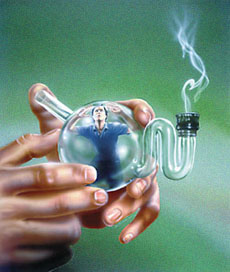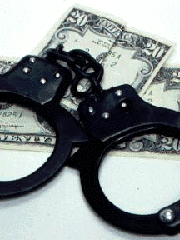|
● Racial Problems
● Poverty
● Drug Abuse
● Crime
● The Abuse of Power
by Government and Corporations
Drug Abuse
 |
|
Drug Abuse in the United States
|
 Drug
abuse in the United States has come to be regarded as one
of the most challenging social problems facing the nation. Indeed,
the very word "drug" excites strong emotions, and opinion
polls since the late 1960s have shown that the "drug
problem" is perceived by most Americans as a major threat
to our society, particularly to its younger members. Drug
abuse in the United States has come to be regarded as one
of the most challenging social problems facing the nation. Indeed,
the very word "drug" excites strong emotions, and opinion
polls since the late 1960s have shown that the "drug
problem" is perceived by most Americans as a major threat
to our society, particularly to its younger members.
 Drug
abuse in the United States is a social problem because it has a
wide range of social costs, or dysfunctions—some obvious and measurable,
some hidden and difficult to quantify. Drug
abuse in the United States is a social problem because it has a
wide range of social costs, or dysfunctions—some obvious and measurable,
some hidden and difficult to quantify.
 |
|
Drug Use and Crime
|
 Crime.
There is a strong association between some forms of drug use and
crime. The use of alcohol, for example, is highly correlated
with violent crime; more than half of those committing murder and
other violent assaults
have consumed
alcohol immediately before the crime. Heroin addiction, too, is
related to crime, although not so directly to violence. Heroin
addicts
may need as much as $100 a day to support their habit, and most
addicts find that they must steal in order to raise these sums.
In addition, users of illegal drugs have indirectly on criminal
networks that manufacture, smuggle,
and distribute these drugs. The profits from this illicit
commerce are vast and the
Mafia and other criminal syndicates have become deeply involved
in the supply of heroin and, more recently, of cocaine. Crime.
There is a strong association between some forms of drug use and
crime. The use of alcohol, for example, is highly correlated
with violent crime; more than half of those committing murder and
other violent assaults
have consumed
alcohol immediately before the crime. Heroin addiction, too, is
related to crime, although not so directly to violence. Heroin
addicts
may need as much as $100 a day to support their habit, and most
addicts find that they must steal in order to raise these sums.
In addition, users of illegal drugs have indirectly on criminal
networks that manufacture, smuggle,
and distribute these drugs. The profits from this illicit
commerce are vast and the
Mafia and other criminal syndicates have become deeply involved
in the supply of heroin and, more recently, of cocaine.
 |
|
A Play about the Mafia
|
 Automobile
accidents. Alcohol use is directly responsible for tens of thousands
of highway accidents and injuries; the drug is blamed for half of
the annual total of road traffic fatalities. Some
60% of all drivers fatally injured in auto accidents have a blood-alcohol
concentration of over .05%, a level that the National
Safety Council considers sufficient to impair driving ability, and
over 35% have a concentration of over .15%, a level high enough
to cause intoxication. The cost of property damage and medical
expenses due to alcohol-related automobile accidents totals about
$1 billion each year. Automobile
accidents. Alcohol use is directly responsible for tens of thousands
of highway accidents and injuries; the drug is blamed for half of
the annual total of road traffic fatalities. Some
60% of all drivers fatally injured in auto accidents have a blood-alcohol
concentration of over .05%, a level that the National
Safety Council considers sufficient to impair driving ability, and
over 35% have a concentration of over .15%, a level high enough
to cause intoxication. The cost of property damage and medical
expenses due to alcohol-related automobile accidents totals about
$1 billion each year.
 Effects
on individuals. Drug dependence takes a significant toll
in terms of personal health and safety. The heavy user
of drugs is much more likely than a member of the general population
to be killed or to commit suicide, either deliberately or
accidentally. Alcoholics, for example, have a death rate nearly
three times higher than that of the general population; they represent
a third of all suicides and are seven times more likely than non-alcoholics
to suffer fatal accidents. Use of heroin increases one's chances
of premature death through overdose, infectious
diseases such as hepatitis and Aids or suicide. Many drugs
have severe and sometimes irreversible effects on mental
as well as physical health. Drug dependence, too, may affect other
areas of the individual's life, ranging from the home to the work
place to personal relationships with friends. Effects
on individuals. Drug dependence takes a significant toll
in terms of personal health and safety. The heavy user
of drugs is much more likely than a member of the general population
to be killed or to commit suicide, either deliberately or
accidentally. Alcoholics, for example, have a death rate nearly
three times higher than that of the general population; they represent
a third of all suicides and are seven times more likely than non-alcoholics
to suffer fatal accidents. Use of heroin increases one's chances
of premature death through overdose, infectious
diseases such as hepatitis and Aids or suicide. Many drugs
have severe and sometimes irreversible effects on mental
as well as physical health. Drug dependence, too, may affect other
areas of the individual's life, ranging from the home to the work
place to personal relationships with friends.
 Economic
losses. The cost of alcohol abuse alone totals over $43 billion
a year in accidents, medical bill, lost production, and so on. It
is difficult, however, to estimate the total economic costs of drug
use. One reason is that there are many indirect costs society must
pay to support drug-dependent persons. Treatment and control of
drug abuse constitute a major drain on law-enforcement and
other public resources. Chronic drug
abusers, for example, may become unemployable and end up on the
welfare rolls. By the mid-1970s, federal and state governments
were spending over $1 billion per year on the treatment of various
drug abusers. Another half billion dollars annually goes into processing
drug users through the criminal justice system. Economic
losses. The cost of alcohol abuse alone totals over $43 billion
a year in accidents, medical bill, lost production, and so on. It
is difficult, however, to estimate the total economic costs of drug
use. One reason is that there are many indirect costs society must
pay to support drug-dependent persons. Treatment and control of
drug abuse constitute a major drain on law-enforcement and
other public resources. Chronic drug
abusers, for example, may become unemployable and end up on the
welfare rolls. By the mid-1970s, federal and state governments
were spending over $1 billion per year on the treatment of various
drug abusers. Another half billion dollars annually goes into processing
drug users through the criminal justice system.
Previous Page Next
Page
|

